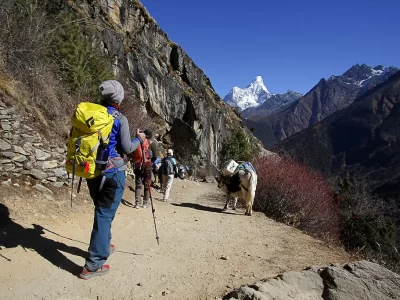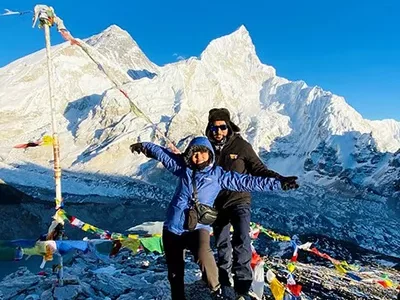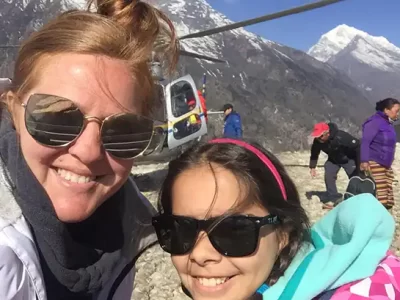The awe-inspiring Everest Base Camp Trek (EBC Trek) invites adventurers to experience stunning Himalayan vistas and the opportunity to stand at the base of the world’s highest peak. It promises breathtaking scenery and an unforgettable trek. But beneath those daunting surfaces lies a difficult trek. This Everest Base Camp Trek Difficulty article is related to the challenges of the Everest Base Camp Trek, examining the physical, environmental, and logistical challenges you may encounter. Whether you’re an avid traveler or an avid explorer, understanding these challenges will prepare you to make an informed decision and prepare for an unforgettable experience of the Everest Base Camp Trek.
Physical Fitness Requirements
Undertaking the Everest Base Camp (EBC) trek necessitates excellent stamina and strength as participants navigate through steep and uneven paths for 5 to 8 hours daily. These paths may include rocky and snow-covered trails. Cardiovascular endurance becomes essential to manage the energy demands of these long trekking days. Strengthening the legs is crucial for handling the steep ascents and descents.
Engaging in aerobic activities like jogging, cycling, or swimming boosts cardiovascular health, while strength training focuses on the legs, back, and core, equipping the body for the trek’s physical demands. Activities such as yoga or pilates enhance flexibility and balance, lowering the risk of injuries. Prospective trekkers should engage in months of physical preparation, gradually increasing the length of hikes across varying terrains to mimic the EBC trail conditions.
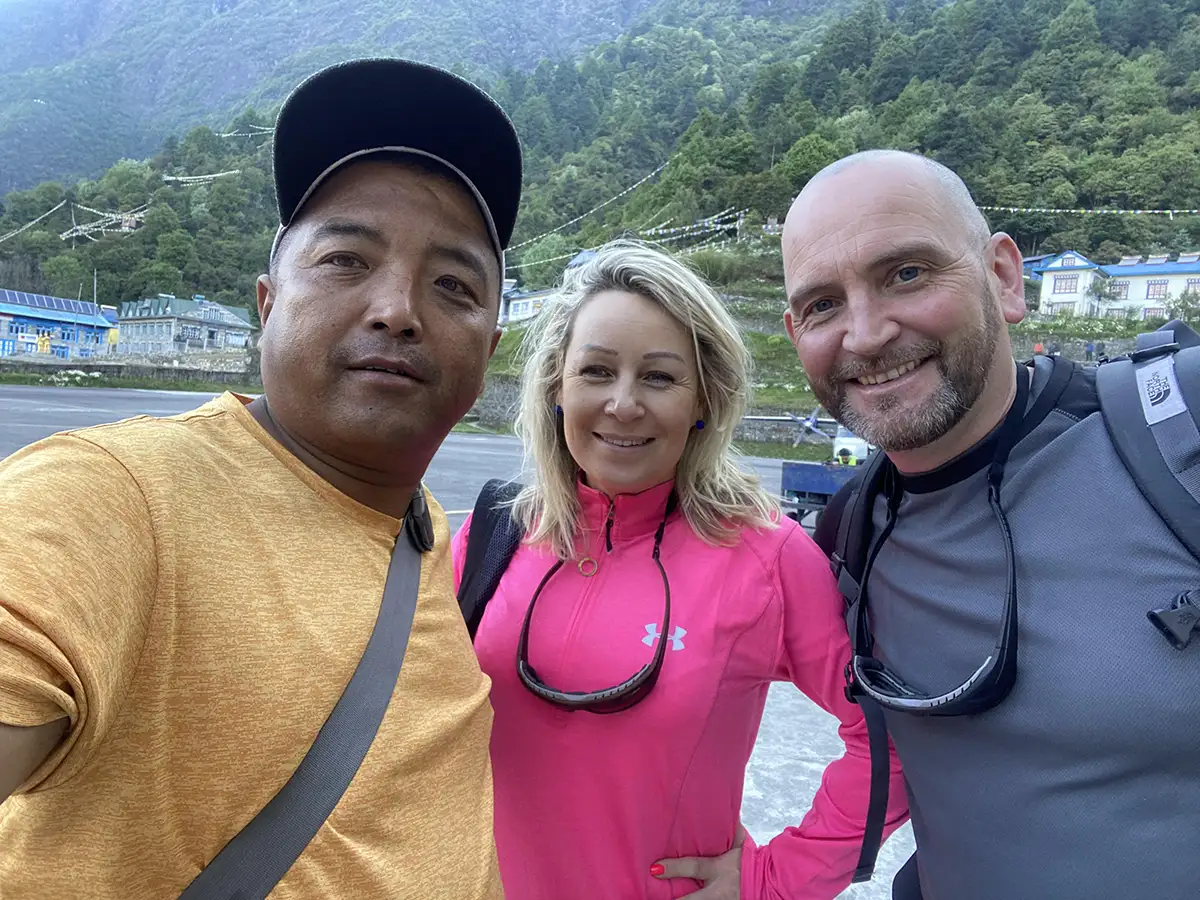
Everest Base Camp Trek Difficulty: Conquering the Challenge of Altitude
Altitude sickness is a major hurdle on the Everest Base Camp Trek, with elevations reaching beyond 5,500 meters (18,000 feet). Here’s how understanding altitude sickness and proper acclimatization can significantly impact your experience:
The Challenge: Altitude Sickness
Thin air at high altitudes means less oxygen available to your body. This can lead to altitude sickness, causing symptoms like headaches, nausea, fatigue, and trouble sleeping.
The Solution: Acclimatization
The Everest Base Camp Trek itinerary incorporates acclimatization days, particularly at key points like Namche Bazaar and Dingboche. These days, they are designed to help your body adjust to the increasing altitude.
- Planned Ascents and Descents: You’ll undertake light activities and short climbs during acclimatization days, followed by descents for sleep. This allows your body to adapt gradually.
- Hydration is Key: Drinking plenty of fluids is crucial to combat dehydration, which can worsen altitude sickness.
- Medications (Consult a Doctor): Under medical guidance, some trekkers might use medications like Acetazolamide (Diamox) to prevent or lessen altitude sickness symptoms.
Be Alert: It’s important to be aware of the signs of severe altitude illnesses like High Altitude Pulmonary Edema (HAPE) and High Altitude Cerebral Edema (HACE), which require immediate medical attention.
By understanding these challenges and incorporating proper acclimatization strategies, you’ll be better equipped to conquer the difficulty of altitude on the Everest Base Camp Trek.
Everest Base Camp Short Trek
Everest Base Camp Trek
Everest Base Camp Trek with Helicopter Return
Everest Base Camp Trek Difficulty: Seasonality Matters
While spring (March to May) and autumn (September to November) are generally considered the most ideal times for the Everest Base Camp Trek due to stable weather, less rain, and moderate temperatures, each season offers unique challenges and benefits:
- Spring: Enjoy stunning displays of blooming rhododendrons and potentially clearer skies after winter. However, be prepared for the possibility of unpredictable mountain weather.
- Autumn: This season boasts clear skies and consistent weather following the monsoon season. But remember, mountain weather can still be surprising.
- Summer Monsoon (June to August): Heavy rain, slippery trails, and an increased risk of landslides make trekking during the monsoon season difficult.
- Winter (December to February): While winter offers fewer crowds and the possibility of clear skies, temperatures plummet, and heavy snowfall can block sections of the trail. Only seasoned trekkers equipped for extreme cold, wind, rain, and snow should attempt a winter trek.
Recommended Training and Preparation Plan
The Everest Base Camp Trek is an incredible adventure, but it’s not without its challenges. Here’s how a well-structured training regimen, starting six months ahead, can significantly improve your ability to handle the difficulty of the trek:
Physical Training:
- Building Stamina is Key: Engage in aerobic activities like running, cycling, and swimming to build endurance for long trekking days on the trail.
- Strengthen Your Core: Focus on exercises that target your legs, core, and back muscles. This will help you manage the demanding terrain and comfortably carry a backpack.
- Simulate the Trek Conditions: Undertake practice hikes in varied and challenging environments. This not only strengthens your body but also builds your mental resilience for the actual trek.
Mental Preparation:
- Know the Path: Research the Everest Base Camp Trek route, familiarizing yourself with the daily challenges and the variations in altitude.
- Understanding Acclimatization: Plan rest and acclimatization days to allow your body to adjust to the increasing altitude.
- Altitude Sickness Awareness: Educate yourself on the symptoms and preventive measures for altitude sickness. This is crucial for ensuring your safety during the trek.
- Set Realistic Goals and Embrace the Challenge: Establish achievable goals and mentally prepare yourself for the physical and mental demands of the trek. This will increase your chances of a successful and fulfilling experience.
By following these tips and starting your training regimen well in advance, you’ll be better equipped to handle the difficulty of the Everest Base Camp Trek and maximize your enjoyment of this once-in-a-lifetime adventure.
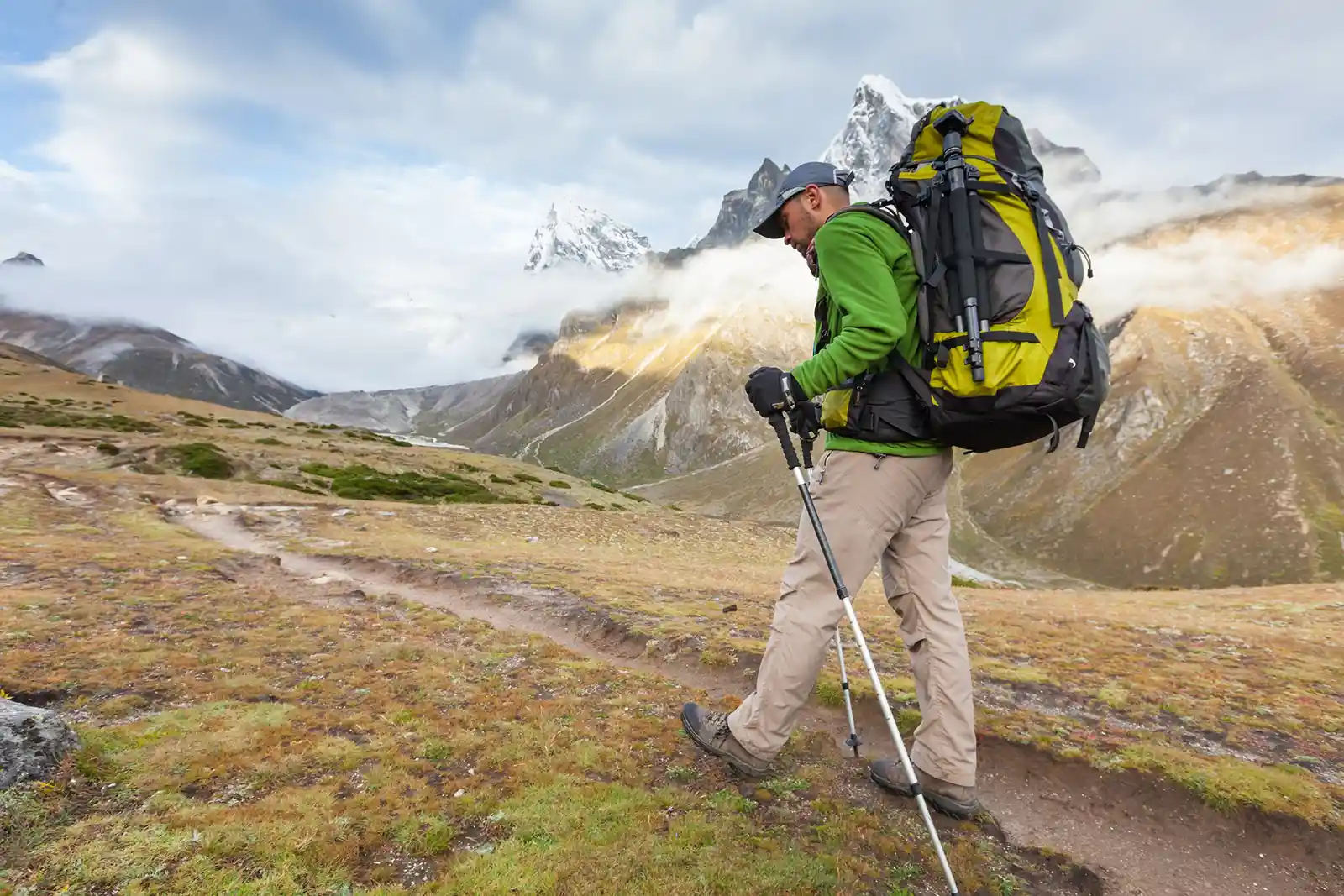
Everest Base Camp Trek Difficulty: Don’t Underestimate the Distance
The length and duration of the Everest Base Camp Trek can be a significant factor in its difficulty. Here’s what you need to know:
A Multi-Day Commitment
The entire trek, including flights to and from Lukla, typically takes around 15 days. However, the core trekking portion is approximately 12 days. This extended timeframe is essential for managing the challenges of high-altitude trekking.
Importance of Acclimatization
The itinerary is specifically designed to incorporate acclimatization stops throughout the trek. These rest days, strategically placed at key points of increasing altitude, allow your body to adjust to the thinner air gradually. This reduces the risk of altitude sickness and makes the overall journey more enjoyable and manageable.
By understanding the length and the importance of acclimatization built into the Everest Base Camp Trek, you’ll be better prepared to tackle the distance and altitude challenges.
Everest Base Camp Trek Difficulty: Death and Risk
While news reports from Everest often highlight danger and fatalities, it’s important to understand the distinction between climbing expeditions and trekking.
- Climbers vs. Trekkers: The reported deaths usually involve climbers attempting the summit, not trekkers on the Everest Base Camp route. These expeditions venture much higher and face significantly more dangers like avalanches, as tragically evidenced by the 2015 disaster at Camp II.
- The Trek Path: The Everest Base Camp trek path itself is generally considered safe from avalanches.
- Trekking Mortality Rate: Accurately tracking deaths on the Everest Base Camp Trek is difficult. News sources estimate 3-5 fatalities per year among the roughly 30,000 trekkers. This translates to a mortality rate of around 0.01%, with high-altitude ailments identified as the leading cause.
Focus on Preparation, Minimize Risks
By properly preparing for the trek’s physical challenges and understanding altitude sickness, you can significantly reduce your own risk. This includes building stamina, acclimatizing properly, and being aware of the symptoms of altitude sickness.
Method to Prevent Everest Base Camp Trek Difficulty
Following certain guidelines makes the Everest Base Camp trek less challenging. The primary concern is mountain sickness from high altitudes, which is preventable with adequate acclimatization. The trek benefits from significant medical support, including helicopter evacuation services, which are available promptly for trekkers from around the globe.
Pick the Right Gear
Like any sport requiring appropriate equipment, multi-day trekking on Everest Base Camp demands careful gear selection. Misjudging the trek as a high-mountain climb leads many to overlook the importance of proper outfitting. Trekking during the rainy season without rain protection, for example, can render the experience futile. Preparation is key, involving packing various items for different needs. So that you know, information on packing lists specific to the Everest Base Camp Trek is essential.
- Ropes for grappling
- ice axes
- Gore-Tex materials
- climbing shoes
- crampons are not necessary for this trek. The trail, being rough, rocky, and strewn with stones
What you need are
- We recommend hiking boots with high ankles
- While a sleeping bag is not mandatory, we advise bringing one
- Down jacket
- At least one warm sweater for indoor warmth
- Several pairs of comfortable, dry hiking pants
- Thick, warm hiking socks
- A hiking backpack with a minimum capacity of 50 liters plus 10 liters
Consideration for a warm hat or head cover, scarf, sunglasses, lip balm, sun cream, trekking poles, headlamp, windproof gloves, water bottle, water purification drops, camera accessories, first aid kit, etc.
Daily Trekking Distances and Elevations
The daily trek on the Everest Base Camp trail ranges from 5 to 15 kilometers, encountering varying terrains and altitudes. Starting in Lukla, which lies at 2,860 meters, the route passes through significant landmarks like Namche Bazaar at 3,440 meters, Tengboche at 3,860 meters, and Dingboche at 4,410 meters, each presenting distinctive landscapes and tests.
Climbing to Everest Base Camp, the trail reaches its highest point at 5,364 meters, necessitating careful progress and consistent acclimatization to cope with the altitude. The trek’s gradual elevation gain allows for a safe adaptation to the increasing altitude, all while trekkers enjoy the magnificent Himalayan vistas. The planned itinerary ensures a balance between daily exertion and acclimatization needs, enhancing both safety and the trekking experience.
Terrain and Trail Conditions
The trek to Everest Base Camp (EBC) spans a diverse array of terrains, starting with lush forests at lower levels and moving to rocky, barren terrains at higher elevations. Rugged paths and steep inclines, often compounded with snow and ice at the upper altitudes, define the trail. Trekkers traverse dirt trails, stone steps, and scree slopes, facing the complexities of glacial paths and moraines near the base camp.
Good physical fitness and the right footwear become crucial for handling these conditions. Prior terrain practice and gear familiarization, particularly with hiking boots and trekking poles, are vital for acclimating to these varied surfaces. The trail’s diversity highlights the need for thorough preparation to tackle sudden shifts in footing and landscape.
Challenges and Risks of the Trek
High altitude and its physiological impacts stand out as the primary challenges and risks on the EBC trek. Trekkers must acclimate to the reduced oxygen levels to prevent altitude sickness, facing the Himalayas’ unpredictable weather, which can swiftly transition to snowfall or rainstorms, rendering the path slippery and dangerous.
The trek’s lengthy durations of walking in demanding conditions contribute to both physical and mental fatigue. Uneven and rugged terrains increase the injury risk from slips and falls. Trekking alongside experienced guides and within a group enhances safety, offering expert support in emergencies. Risk minimization requires thorough preparation, risk awareness, and a careful approach.
Tips for a Successful and Enjoyable Trek
Here are some strategies for a fulfilling and enjoyable trek:
- Advance Training and Preparation: Tackling Everest Base Camp’s challenges starts with early training to boost fitness levels. Engage in cardiovascular, strength, and hiking activities to condition your body for the trek’s demands.
- Smart and Light Packing: Opt for minimalism in packing, carrying only necessities to reduce backpack weight. Include essential trekking gear, comfortable clothing, durable footwear, sunscreen, insect repellent, and a quality sleeping bag.
- Gradual Pace and Acclimatization: Acclimate to higher elevations by trekking slowly and pacing yourself. Heed your body’s signals, hydrate regularly, and adjust to altitude incrementally.
- Hydration and Nutrition: Stay hydrated, consume plenty of water, and use water purification methods to drink from local sources. Fuel your trek with energy-rich meals, leaning on carbohydrates and proteins, and try local dishes like dal bhat for a nutritious boost.
- Guidance and Safety Adherence: Employ a seasoned guide for their regional knowledge and trekking expertise. Follow their advice on safety, altitude sickness, and trekking practices to enhance your journey’s safety.
- Cultural and Environmental Respect: Honor the Sherpa community’s culture and traditions in the Khumbu region. Practice “leave no trace” principles, manage waste responsibly, and protect the environment.
- Personal Well-being Focus: Prioritize your physical and mental health, using sunscreen and wearing a hat for sun protection. Take breaks for rest and enjoyment, immersing yourself in the majestic views and unique experiences.
- Balanced Photography and Experience: While capturing memories is important, also engage directly with the surroundings to fully embrace the trek’s beauty. Temporarily set aside technology to connect more deeply with nature.
- Weather Preparedness: Anticipate and adapt to the Himalayas’ unpredictable weather by carrying suitable clothing layers and rain gear and readying yourself for any climatic shifts.
- Journey Enjoyment and Achievement Recognition: Relish the trek and the milestones you achieve, treating the expedition as an extraordinary adventure that tests and reveals your capabilities. Appreciate the stunning vistas, fellowship with other trekkers, and the fulfillment of reaching your goal.
Conclusion
The Everest Base Camp trek is an iconic adventure, but it’s important to be aware of the challenges it presents. Here’s a final thought on how to approach this trek:
Preparation is Key
While the Everest Base Camp trek is a well-established route with safety checkpoints, guesthouses with basic amenities, and even occasional WiFi, the key to truly enjoying this challenging trek lies in proper preparation.
By understanding the difficulties beforehand, you can develop a training plan, research acclimatization strategies, and pack appropriately. This will not only boost your confidence but also significantly enhance your experience on the trail.
Embrace the Challenge, Reap the Rewards
Many trekkers successfully conquer Everest Base Camp each year. With the right planning, the challenges you encounter can be transformed into a sense of accomplishment. The breathtaking views and the experience of standing at the base camp of the world’s highest mountain are truly unforgettable.
So, take the time to understand the difficulties of the Everest Base Camp Trek. Equip yourself with the knowledge to navigate them and start a rewarding and joyful expedition.

